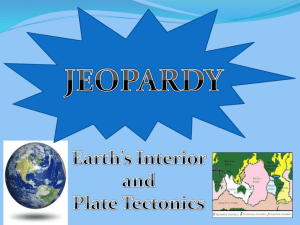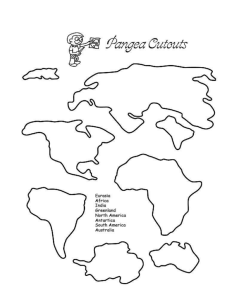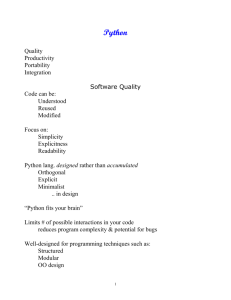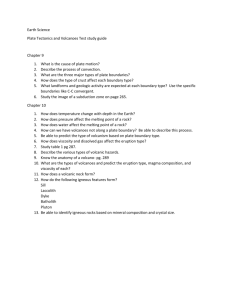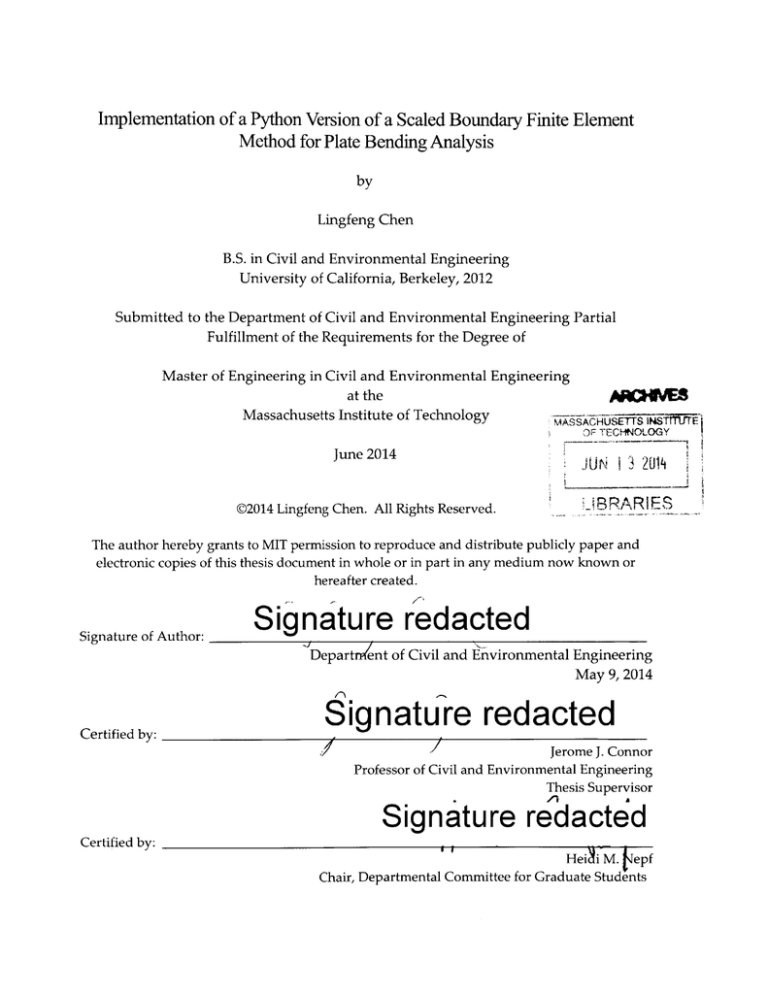
Implementation of a Python Version of a Scaled Boundary Finite Element
Method for Plate Bending Analysis
by
Lingfeng Chen
B.S. in Civil and Environmental Engineering
University of California, Berkeley, 2012
Submitted to the Department of Civil and Environmental Engineering Partial
Fulfillment of the Requirements for the Degree of
Master of Engineering in Civil and Environmental Engineering
at the
Massachusetts Institute of Technology
M#*VE
XHET NsiT
OF
TECHNOLOGY
June 2014
@2014 Lingfeng Chen. All Rights Reserved.
BRA RI ES
The author hereby grants to MIT permission to reproduce and distribute publicly paper and
electronic copies of this thesis document in whole or in part in any medium now known or
hereafter created.
Signature of Author:
Signature redacted
Departm ent of Civil and Environmental Engineering
May 9, 2014
Certified by:
Signature redacted
Jerome J. Connor
Professor of Civil and Environmental Engineering
Thesis Supervisor
Signature redacted
Certified by:
Heii M. fepf
Chair, Departmental Committee for Graduate Students
2
Implementation of a Python Version of a Scaled Boundary Finite Element
Method for Plate Bending Analysis
By
Lingfeng Chen
Submitted to the
Department of Civil and Environmental Engineering on May 9, 2014
In Partial Fulfillment of the Requirements for the Degree of
Master of Engineering in Civil and Environmental Engineering
ABSTRACT
Common finite element programs for plate bending analysis are complicated and limited by the
common plate theories. Such programs are usually not user-friendly for designers to implement.
Lately, Hou Man et al. from the University of New South Wales has developed a technique for
unified 3D plate bending analysis using scaled boundary finite element analysis, which promises
to have little restrictions on plate thicknesses and faster convergence. This thesis presents an
implementation of a python version of their method, which, when combined with a modeling
program like Rhinoceros, aids designers in studying plate bending behavior under static loading.
It represents a first step in the development of interactive programs for structural design and
analysis of plates.
Thesis Supervisor: Jerome J. Connor
Title: Professor of Civil and Environmental Engineering
ACKNOWLEDGEMENT
First, I would like to express my gratitude to my thesis supervisor, Prof. Jerome J. Connor, who
has provided precious guidance and advice on my thesis.
Second, I am grateful to Hou Man from University of New South Wales, who has generously
helped with my understanding of the scaled boundary finite element method quoted in this thesis.
Third, I want to thank my parents for supporting my study at MIT, both financially and mentally.
Last but not least, I want to extend my gratitude to my instructors, my classmates and my friends
for their supports.
5
6
Table of Contents
A BSTRA CT ....................................................................................................................................
3
A CKN O W LED GEM EN T ..............................................................................................................
5
CH APTER 1: IN TRO DU CTION ...............................................................................................
9
1.1 Background ...........................................................................................................................
9
1.2 Existing Finite Elem ent M ethods.......................................................................................
9
1.3 Existing Design Tools.........................................................................................................
10
1.4 Objective and Scope ...........................................................................................................
11
CHAPTER 2: METH O DOLOGY .............................................................................................
13
2.1 Scaled Boundary Finite Elem ent M ethod .......................................................................
13
2.2 Unified 3D-based Technique for Plate Bending Analysis ...............................................
13
2.2.1 Isoparam etric Form ulation.........................................................................................
14
2.2.2 Scaled Boundary Finite Elem ent Equations ............................................................
17
2.2.3 High-Order Spectral Elem ent ....................................................................................
18
2.2.4 Solution Custom for Thin to M oderately Thick Plate .................................................
20
CHA PTER 3: PY TH ON IM PLEM EN TATION ..........................................................................
25
3.1 Python, Rhinoceros and Grasshopper ..............................................................................
25
3.2 O ther Utilized tools.............................................................................................................
25
3.3 Grasshopper Canvas............................................................................................................
26
3.4 Python Codes ......................................................................................................................
27
3.4.1 Im port...........................................................................................................................
27
3.4.2 Legendre-G auss-Lobatto Integration Points ............................................................
28
............................................................................
30
3.4.3 G eom etry.........................................
3.4.4 Generating Shape Functions, Derivatives and Jacobean Matrices ...........................
30
3.4.5 G enerating [E 0 ], [E'], [E 2 ] ........................................................................................
32
3.4.6 A ssem bly of Stiffness M atrix ..................................................................................
33
3.4.7 Solver ...........................................................................................................................
33
CH A PTER 4: D ISCU SSION ........................................................................................................
7
37
CHAPTER 5: CONCLUSION............................................39
REFERENCE............................................................................................
8
41
CHAPTER 1: INTRODUCTION
1.1 Background
Analysis of plate and shell structures is an important topic in structural engineering since plates
are used everywhere in structures. A plate is a three dimensional object that is bounded by two
plane surfaces and a cylindrical surface [1]. Plates transfer loads through bending. Many structural
elements, such as floor slabs, gusset plates and bridge decks, can be modeled as plate structures.
As computer aided structural analysis for plates has become more viable, plate elements are now
used extensively in structures [1]. The exact solutions to the plate bending problems requires
solving fourth order partial differential equations, which is difficult for complex geometries. Thus,
numerical procedures such as finite element methods are used [2].
1.2 Existing Finite Element Methods
Compared to other several common finite element methods for plate bending analysis, an extended
scaled boundary finite element method yields general solutions to plate bending problems while
maintaining the balance between accuracy and efficiency. Common finite element methods
developed for plate bending problems tend to discretize objects with 2D plate finite elements
because using general 3D finite elements with high aspect ratio, or distorted shapes, would cause
large approximation errors while it is computationally expensive to use lots of low-aspect-ratio 3D
elements [2]. Although Mindlin/Ressiner theory can be applied to both thick and thin plates, the
stiffness matrices require additional stabilization process when reducing shear locking phenomena
it introduces. Shear locking phenomena happen when the elements become overly stiff as they
become thinner and their shear stiffness dominates [2]. Mixed/hybrid formulation includes
additional mechanical variables to be approximated independently from displacements; the pversion finite element method looks into eliminating shear locking problems with high-order
elements, which uses greater numbers of element nodes in approximation [2]. Methods that are
based on the approaches mentioned above are still not sufficient to yield a generalized solution,
9
partly because the plate theories introduced in the governing equations in formulations are not
consistent with the 3D theory [2]. On the other hand, a pq-adaptive procedure for plate structures
is developed using 3D finite elements, but it remains questionable whether the approach is both
accurate and efficient [2]. Recently, Hou Man et al. from University of New South Wales in
Australia has proposed a generalized solution for plate bending problems by extending the scaled
boundary finite element method, which is a hybrid involving both the boundary element method
and the finite element method [2]. The technique uses 3D governing equations to avoid shear
locking issues, a scaled boundary finite element method to reduce the numbers of degrees of
freedom, high-order spectral elements, and Kirchhoff plate theory to further reduce the
computational expenses. The technique is promising in practice, but has not yet been implemented
in any commercial finite element analysis program at this time.
1.3 Existing Design Tools
When it comes to plate bending analysis, tools either are too complicated in setting up models or
lack user interactions for design purpose. Architectural design and modeling programs, such as
AutoCAD and Rhinoceros, usually do not come with finite element analysis tools. Multi-purpose
finite element analysis programs, such as ADINA and ANSYS, are complicated in creating finite
elements and setting up meshes. Structural finite analysis programs, such as SAP 2000 and GSA,
are not user friendly for structural design and modeling from scratch. Both types of finite element
analysis programs usually complement architectural modeling programs for complete structural
design and analysis which involves importing and exporting models of different types, which is
inconvenient for designers who desire rapid feedbacks on structural performance of their design.
Specialized programs, such as RAM Structural System, and plugins in architectural design and
modeling programs help remove the bottleneck in design process as stated above, but they still
impose restrictions on component types and dimensions on plate structures. Designers, especially
who don't often acquire the knowledge of plate theories, are still looking for an interactive tool
that can aid their design and analysis of plate structures simultaneously.
10
1.4 Objective and Scope
This thesis presents an implementation of Hou Man et al.'s method for plate bending analysis using
the programing language Python. It also presents an example of how the method can be extended
to existing modeling programs such as Rhinoceros, which would allow users to create interactive
tools for structural design and analysis of plates.
11
12
CHAPTER 2: METHODOLOGY
2.1 Scaled Boundary Finite Element Method
The scaled boundary finite element method (SBFEM) is a novel computational procedure with a
better balance between accuracy and efficiency than conventional numerical methods. The
SBFEM bases its coordinate system on three directions: a radial direction and two local
circumferential directions [3]. The boundary of the object is discretized with surface finite
elements in circumferential directions [3]. The governing partial differential equations can then be
transformed into ordinary differential equations in the radial coordinates, with coefficients
approximated using the finite elements created. The ordinary differential equations can then be
solved analytically [3]. Both attractive features of finite element and boundary element methods
are inherent in the SBFEM. Like the finite element methods, the SBFEM requires no fundamental
solution and it is not complicated to extend its applications to other spectrum [3]. No singular
integrals are introduced and the results are always symmetric [3]. Like the boundary element
methods, the SBFEM approximates the boundary elements only, reduces the special dimension by
one and strictly satisfies boundary conditions infinitely away [3]. Thus, extending the SBFEM to
solve plate bending problems would benefit the implementation in this thesis, by cutting down
computational expense and increasing accuracy with semi-analytical approaches.
2.2 Unified 3D-based Technique for Plate Bending Analysis
With SBFEM, a 3D-based finite element can be performed on plate structures without enforcing
thickness restrictions on plates. Hou Man et al. has developed such method to analyze bending
stress of plates under static loading and within linear elastic range of material properties [2]. The
method utilizes weak formulations and 3D governing equation, and work for both thick and thin
plates. The method is not limited by the kinematics of Kirchhoff plate theory, which is only used
to reduce the number of degrees of freedom and relate results to the conventional plate theory.
Analytical results on transverse direction can be obtained through ordinary differential equations.
The method also utilizes spectral element methods on in-plane dimensions to deal with elements
13
..
...
mm -.........
......
....
........
..
..
..........................
with curved boundaries and converge faster with fewer elements than conventional finite element
methods. In the following sections, selected equations from Hou Man et al.'s method are presented
[2] [4].
2.2.1 Isoparametric Formulation
Figure 1 shows a plate of constant thickness t. A Cartesian coordinate system is applied in the
model: the Z-axis lies along the transverse direction of the plate; the X- and Y- axes lie parallel to
the plane surfaces. An isoperimetric element is chosen to be a 2D rectangular plate. A Cartesian
coordinate system is also applied to the element, where ri- and
C-lie in-plane at the bottom of the
element surface and parallel to the edge of the element.
*
z
top-plane (-
Figure 1 3D Scaled Boundary Coordinateswith Scaling Center at Infinity [2]
ux = ux (x, y, z), uy= uv (x, y, z), uz = uz (x, y, z) denote displacement components on the plate. {u}
={u (x, y, z)) = [uz, Ux, uY] T is the displacement vector. The strains
as
14
()
=
(
(x, y, z)} are arranged
8
x
{e}{u}
(1)
_xz_
With the differential operator
Oz
[L]>
010
0
0 )
Oy
0
ax
0
0
(2)
a)z
aex
{a (x, y, z)} have linear relationships with {e}
From Hook's Law, the stresses {u}
{}
v
(3)
xy
where [C] is the elasticity matrix [5]
1
__
1,
V
0
0
0
1
v
0
0
0
[C]=)
(4)V
(1+v)(1-2v)
o
2 ( -v)
0
0
0
0
1-2
2(1-v)
0
0
0
0
0
0
1-2v
The in-plane dimensions of the plate are discretized and transformed to the isoparametric elements
shown in Figure 1. Coordinates are interpolated using shape functions
[N]
[N (qz,
C)] =N
1
(qj, C), N2 (i.
4), .1 formulated
15
in the coordinates q~and C [2]
(5a)
)=[N]{x}
x(rq,
y(q,)
(5b)
=[N]{y}
Only x and y coordinates are required to transform to and from q and C coordinates. The SBFEM
here employs a scaling center at the infinity and translates the 2D mesh along z-direction. So
_ _I
J
Y,
-Y,7
--x
X"
(6)
a7
where IJI is the determinant of the Jacobean matrix
LIX,
-Y -
Y,,,
(8)
An element in [J], such as x,,, can be determined as
x,
x,=
[N],, {x} = [N,, (q,), N 2 ,,J(,).]
x2
(9)
An infinitesimal area in the x-y plane
dS = dxdy = IJdqd
(10)
From equations (2) and (7), the differential operator is now
[L]=(bl
az
+(,b
2
10r7
+(1b 31
a{
where
10 0
b0 00 0 0
0 0 1
I 01 0lb 2=
,
0
0
0
0g
0
0
0
0
"
0
-X1
~{ 0
16
y
0
(13)
0
0
-_v,,7
0
0
0
b
=
0
0
X, 1
,77
-y
-
'
(14)
7
0
0
0
0
So the strain field can be expressed as
= b]
Ju}, + [b2]u} +[3
bJul
(15)
2.2.2 Scaled Boundary Finite Element Equations
The displacement field in the plate is represented semi-analytically in the z direction [2].
{u}
=
[N ] [0]
[0] [N]
[0] - u (z)j
[0] {ux(z)}
-0]
[N]_- ju.,(z)j
[0]
(16)
=[N]{u(z)}
From equations (15) and (16), the strain field can be represented semi-analytically by displacement
by {u (z)}
{} = [B']{u(z)}
+[B2]{u(z)}
(17)
where
B2
=
[B] = b'] [N]
(18a)
[b] [N],, + [b'] [N],
(18b)
and the stress field is expressed as
{oj
=
[C]([B' ]u (z)}"
+
[B2]u(z)})
(19)
Hou Man et al.'s derivation shows that both conditions in the following need to be satisfied:
{F(z,)}= -q(z,)}
(20a)
{F(z 2 )I
(20b)
={q(z 2 )I
and
17
[Eo ]u(z)}1,
+ ([E]T -[E ]){u(z)}
-[E2]{u(z))=
{O}
(21)
where {F (z)} is the external nodal force, {q (z)} is the internal nodal force expressed as
+ [E' ]T
{q(z)} = [EO] {u(z)
{U (z)}
(22)
and [E0], [E'] and [E2] denote the coefficient matrices
(EO
(23a)
= s([B'] [C](B']|Jjd77d4
E 2 ]-
(23b)
[C][B'] |Jdid
[El] = s [B2 ]T
(23c)
s[B2] T [C][B2]|JId7dd
Equation (21) is the SBFEM equation in displacement for plate structure. [E)], [E'] and [E2] are
to be assembled using conventional finite element method.
2.2.3 High-Order Spectral Element
Hou Man et al.'s method discretizes the in-plane dimensions of the plate structure with high-order
spectral elements [2]. The 2D shape function [N] in the previous section is determined as the
product of two ID shape functions with respect to local q and
coordinates, respectively. The two
1 D shape functions are defined similarly. With the local coordinate, take r as example, in a range
of -1 < il < 1, a 1 D element of order p has p+1 nodes. The nodal locations are determined using
Legendre Polynomials Ln. Ln is defined by the recurrence relation [6]
{
(q)
Ln+ 1 (q)
=
(24)
1
7L(
=
n
-l
(7)
Except for the nodes on the two end, the p-i nodes in between are located at the Gauss-LobattoLegendre points, which are the roots of
L' M = 0
(25)
where L 'p is the derivative of Lp [2]. The ID shape function is Lagrange polynomials
p+l
N,
=
)-7
k=l,ksl
18
77i - 7k
(26)
and it exhibits such property at the node q;
N 0
)= 6i
(27)
O ( )
(28)
where 6 is the Kronecker delta
I
The integration points happen to be at the nodes when Gauss-Lobatto-Legendre quadrature is used
for numerical integration, so the integration can be approximated with respect to individual node
iji
[7]
p+1
F (q) dq
wF (77,
(29)
(qi))2
(30)
The weight wi at the point qi is
2
p(p+1)(L,
So, for 2D integration, the shape function is obtained by
N, (77,)
= Nk, (q) N, (e)
(31)
where the local nodal number i is obtained from the nodal numbers k and I of the two 1 D shape
functions
i=(l-1)(p +1)+k
(32)
Also, the 2D shape function exhibits such property
N',(77,
45)=k,
(51 =15i.
(33)
where
)=(/ -1)(p +1)+ a
(34)
W,= Wk W,
(35)
The weight can be obtained as [4]
The 3
x
3 submatrix of[E0] related to the ith andjth nodes is simplified as
[EO
= y
(Lb'] T [C][b'])|J|
with
19
(36)
bl [C]bl]=G
1
0
(37)
where G is the shear modulus
G
(38)
2(1 + v)
Note that [E0] only consists of positive diagonal blocks.
Similarly, the 3
x
3 submatrix of [El] can be expressed as
[E]
The 3
x
[C][b']|J|
=W[B7]
(39)
3 submatrix of [E2] has to be evaluated element-by-element
(Ej = JjWa,6
a=1
9,,
B|ra{)[](
J|
(40)
=1
2.2.4 Solution Custom for Thin to Moderately Thick Plate
Hou Man et al. have developed a general solution to the previous SBFEM equations for general
3D plate structures [2]. They have also obtained a tailored solution for thin plates that utilizes the
kinematics of the Kirchhoff plate theory to reduce the number of degrees of freedom and simplify
the results, where displacements and force resultants of the plate can be obtained directly [4]. The
tailored method is later implemented in this thesis.
General Solution for 3D Plate Structure
By introducing the variable [2]
{X(z))=
{q (z)}
(41)
the SBFEM equation (21) can be transformed as
{X(z)}
= -[Z]{X(z)
20
(42)
with the coefficient matrix [Z] as
[Z]=E]'[']
[-
[E
(43)
E
]
+[E1][Eo]-'[E]
- E][Eo]
The general solution to {X (z)} is in the form
{X (z)I = e-[z]z {c}
(44)
where {c) are the integration constants and e-z is a matrix exponent, which can be approximated
using Taylor series
e-[Z]z _
(45)
-Zz
i- O
-
or Pad6 expansion, which converges more rapidly to the solution [4]
-, (P(z)]
e [Zz '&[(
(46)
where [P (z)] and [Q (z)] are polynomials of -[Z]z.
When substitute in zi = 0 for the bottom surface and z2 = t for the top surface, the SBFEM equation
(42) can be rewritten as [2]
[S]
{UB}~
{FB}1
FT}
=
{U
(47)
with the stiffness matrix [S]
[S]=[/
LV
I]-[
22
]V] 2 I I ]
[V22 I [V12
]
(48)
where
IV]= e-Z=
jIV] I[Vf ]]
12
I[
21 I
[
22
(49)
_1
The subscripts B and T denotes the bottom surface and the top surface respectively. [V/] is
approximated using either Taylor series as equation (45) shows or Pade expansion as equation (46)
shows.
21
TailoredSolution Using Kinematics of Plate Theory
Hou Man et al. use Pad6 expansion of order (2, 2) in their research since this is accurate enough
for thin to moderately thick plates; when "t /L << 1, where L is shortest span of the plate, higher
order terms of -[Z]z become negligible" [4]. In Pad6 expansion of order (2, 2), [P (z)] and
[Q (z)] in equation (46) are picked as below
[Z] +z 2 [V]
(50)
[Q(z)] =[I]+2 z[Z]+z 2 [V]
(51)
[P(z)j = [ I -z
2
with
[V]=
(52)
[Z]2
By applying a transformation matrix [T] and kinematics of plate theory, the number of degrees of
freedom in the SBFEM equation (47) can be further reduced.
With
[IP] [I]
[T]=t2
(53)
the displacement vector in SBFEM equation (47) can be transformed
{UB}
G UT}-{UB})
{T] }
L{UT}T
l
-({uT}+{uB})
I
f{
I
}
1U}
(54)
[.2
where [0] means the rate of change of displacement over the thickness and {t} means the average of
displacements on the top and bottom surfaces. And with
[Tr]-T
-[I] -[I
t
2
_t
2
the forces in the SBFEM equation (47) can be transformed
22
(55)
2
Fl-
I
[T
{T
(56)
where {M} is the difference of the forces of the surfaces multiplying half of the thickness and
{F} means the average of the forces on the surfaces.
For t /L << 1, using the transformations (54) and (56), the SBFEM equation (47) can be simplified
{{M}}
as
[{{6}}
M = tI(57)
[s]
with the stiffness matrix
[s]=t
]
](E[I]+t2
IE
[E]T
[l(58)
1)
E([I]+ t2[V1])-t2
1
[V2|(
When applying the kinematics of plate theory, it is assumed that the out-of-plane deformations are
symmetric with respect to the mid-plane
(59a)
{UTZ}={UBz}={U
And the in-plane deformations {u.} and {uy} are equal and opposite for the top and the bottom
surfaces
Iu
}
(59b)
{uy}
(59c)
{U=-{u} =U
{UT}
= -=
With the assumptions (59), the SBFEM equation (57) can be rewritten as
][s4
Lsi~~~~~
s14]
[Sil
IS12
[13
Is21]
Ls22 1
[s23
[s5
[s
1
rs]
Is 24
Ls2 5 i
s26]
[N31] [s32]
s33] IS34
[35]
L36 ]
IS 4 1]
Fs4 3 ]
]44[s45]
s 46 ]
[S42
FS51IS
s 5 2]
F 5 3 ] [s 5 4 ]
[S55
Ls61]
s62]
Ls63]
Is65]
s 6 4]
11]H o
s'161
~~~
F--,,F
2
(FT
{UFTZ
LI56]
s6 6
(
20
L(FTi-{FBZ
(I
_
-FBy
>
(60)
+jFBz
{0
FTx +1FBx}
{}
f7, +{FB i
Eliminating the rows and columns with zero entries in the displacement vector, the SBFEM
equation (60) becomes
23
[s22]
[S23]
[{M
[s24]
[s33] [s34] jl{}r
S[s32]
[s42] [s43]
[s44]
=I
{M,
1
>
(61)
[
{w}
where the matrix on the left hand side is the submatrix of the stiffness matrix [s] defined in
equation (58), Oy and 0, are rotations about the in-plane axis, and w is the out-of-plane deflection,
or
{0,}
(62)
tu,)
=<
{uz }
The stiffness matrix [s] defined in equation (58) can be assembled using submatrices of [V defined
in equation (52) and submatrices of [Z] defined in equation (43).
[Vu]=
[V]=
I ([ZI]2 +[ 12][Z21 )
([Z 21 ][Z]-[Z
11]
[Z 2 ])
(63)
(64)
[Z]=E
[EO ]1[El
(65)
[Z 2 ]= -[E]'
(66)
[Z 2,]=-[E2] + [E'] [E'
24
[E' ]T
(67)
CHAPTER 3: PYTHON IMPLEMENTATION
3.1 Python, Rhinoceros and Grasshopper
Based on Hou Man et al.'s method presented in the sections above, the implementation in this
thesis uses the programing language Python. Python is a general purpose, object-oriented scripting
language that enforces the readability of codes [8]. Python can run on lots of different platforms.
It is free, even for commercial purposes [8]. The syntax is simple and high-level data structures
can be used [8]. A large amount of extension modules maintained by members of Python user
community can be installed to expand the scope of the application of Python. Many programs
could include a Python script editor and compiler to interpret written codes and provide
customizable functions. Thus, designers with or without programing background would embrace
Python for its simplicity and powerful capability.
Rhinoceros and grasshopper, prevalent tools in the design industry, can incorporate Python scripts
to allow desired functions. Rhinoceros is a commercial computer-aided design program aimed to
provide better user experience in 3D modeling. Grasshopper, a plugin of Rhinoceros, is a graphical
algorithm editor [9]. Users may create automated work flows by dragging Grasshopper
components into the Grasshopper canvas and connecting them. The Grasshopper components may
prompt inputs, perform arithmetic, implement commands in Rhinoceros, or display outputs. Users
may find the combination of Rhinoceros and Grasshopper convenient with form generating, basic
structural analysis and parametric modeling, which enables design options generated from initial
parameters. Both Rhinoceros and Grasshopper have numerous plugins users can find to extend the
usage. One of the Grasshopper plugins, GhPython allows user-defined Grasshopper components
using Python scripts [10]. With the aforementioned tools, the Python implementation of the
SBFEM can be compiled, or interpreted and run, in the modeling program for rapid feedback on
plate bending performance.
3.2 Other Utilized tools
25
Besides Rhinoceros, Grasshopper and GhPython, some other non-built-in tools are also used in
the example of Python implementation below. NumPy is a fundamental package for scientific
computing with Python [11] [12]. It provide modules that can create array objects of N-dimensions
and manipulate array objects resembling matrices with matrix operations. "utility.py" is a script
developed to contain handy functions for users of GhPython to use [13], functions including
unifying types of inconsistent Rhinoceros geometry objects. These tools, although not mandatory
for the implementation, would expedite the Python script writing in GhPython.
3.3 Grasshopper Canvas
Besides the Python script writing, the example below uses Grasshopper components to interact
with users. An example of Grasshopper definition is shown in Figure 2. Each link in between
components transfers the data from one output of the component on the left end of the link to the
input of that on the right end of the link. Titles of the components can be renamed for ease of
readability. On the left hand side of Figure 2, number sliders and panels are Grasshopper
components permitting users to input numbers. "Element Nodes" is a point geometry component
that can set and collect points in Rhinoceros modeling world. Analogously, "Element Edges" and
"Integration Points" are geometry components that collect the output lines and points. The white
color shows that the previews of the component are turned on and they are drawn in Rhinoceros
modeling world. "Python Lglnodes" and "Python Integration" are customized components created
through GhPython. The GhPython components can store Python scripts and compile them. They
also allows adding or removing inputs or outputs with editable names.
26
0.500O
* 20
Figure 2 Example GrasshopperDefinition with GhPython Components
The example built here would allow people to compute the bending moments and transverse
deflections of a rectangular plate element with proper boundary conditions and loading inputs.
"Element Nodes" takes in four vertexes of the rectangular plate element either clockwise or
counterclockwise. "Python Lglnodes" takes in the number of node order to generate the positions
and the respective integration weights of integration nodes of a 1D spectral element. "Python
Integration" then receives the existing information and generates the corresponding integration
nodes on the elements and the stiffness matrix. With users manually input the boundary conditions
and loading information, "Python Integration" can then approximate the bending moments and
transverse deflections of each node. The following sections explain the functions of different parts
of the codes.
3.4 Python Codes
3.4.1 Import
In both "Python Lglnodes" and "Python Integration" components shown in Figure 2, the module
NumPy is imported at the beginning and renamed as "np" temporarily for shorthand as Code Block
1 shows. Due to some incompatibility issues at this time, a built in module called "clr" is imported
and add reference to "mtrand" to help the compiler import NumPy smoothly [12].
27
import clr
cr .AddReference ("mtrand")
import numpy as np
Code Block 1 Importing the Modide NumPy
In "Python Integration", some other useful modules are imported also, as Code Block 2 shows.
Rhino.Geometry
helps
to
create
and
identify
Rhinoceros
geometry
objects.
Ghpythonlib.components and rhinoscriptsyntax contain python interpretation of Rhinoceros and
Grasshopper commands. Sys is a Python built-in module that helps manage the logistics of the
compiler.
import sys
import utility
import ghpythonlib.components as ghc
import rhinoscriptsyntax as rs
import Rhino.Geometry as rg
Code Block 2 Importing Modules other than NumPy
Code Block 3 in "Python Integration" pre-processes its inputs. The points taken in are forced to be
converted to general Rhinoceros point geometry objects. "xp", "yp" and "zp" are the x, y, z
coordinates of the points in Rhinoceros modeling space. The positions and the integration weights
of the ID element nodes are converted to row vectors. "n" denotes the number of 1 D element
nodes.
## Import
points=utility. coerce3dpointlist (points)
xp,yp,zp=ghc.Deconstruct(points)
x=np . array (x)
w=np . array (w)
n=len (x)
Code Block 3 Pre-Processing(fInputs
3.4.2 Legendre-Gauss-Lobatto Integration Points
28
Code Block 4 in "Python Lglnodes" is a Python version of Greg von Winckel's MatLab code:
Legendre-Gauss-Lobatto nodes and weights [14]. Using recurrence definition of Legendre
polynomials, the codes generate ID Legendre-Gauss-Lobatto node positions and integration
weights based on the number of orders, and stored in "x" and "w" respectively.
Ni=N+1
x=-np.cos(np.pi*np.arange(O,N).T/N)
P=np.empty( (N1,N1))
xold=2
while (np.abs(x-xold)) .maxo>np.spacing(i):
xold=x;
P[:, 0] =1
P [:, i]=x
for k in range (2, N1):
P[:,k]=((2*k-i)*x*P[:,(k-1)]-(k-i)*P[:, (k-2)])/k
x=xold-(x*P[:,N]-P[:,(N-1)])/(N1*P[:,N])
w=2/(N*Ni*P[:,N]**2)
x=x . tolist ()
w=w.tolist()
P=P. T
Code Block 4 Legendre-Gauss-LobattoIntegration Pointsfbr ID Elements
2D integration points and their integration weights are then generated with Code Block 5 in
"Python Integration". "xp4" and "yp4" stores the x and y coordinates of the element nodes
respectively. "Eta 1" and "Zeta 1" denotes the local coordinates of the element nodes. "w i" stores
the integration weights of the element nodes.
##Generate Integration Points
a=(+x) /2
xpi=(xp[3]-xp[0])*a+xp[Q]
xp2=(xp[21-xp[1])*a+xp[1]
yp1=(yp[31-yp[0])*a+yp[0]
yp2=(yp[21 -yp[1] )*a+yp[1]
xp3=np. empty ( (n, n))
yp3=xp3.copy()
w =xp3.copy()
Eta=xp3.copy()
i=0
while i<n:
xp3[i]=(xp2[i]-xp1[i])*a+xp1[i]
yp3[i1=(yp2[i]-yp1[i])*a+yp1[i)
w_ [i]=w[i]*w
Eta[i]=x
i+=1
29
xp4=map (float, xp3.flatten (0))
yp4=map (float, yp3 . flatten (0))
w i-map(float,w .flatten(0))
Etal=map(float,Eta.flatten(0))
Zetal=map (float,Eta. flatten (1))
Code Block 5 Legendre-Gauss-LohattoIntegration Points Jfr 2D Elements
3.4.3 Geometry
For preview of the element shape, Code Block 6 in "Python Integration" generate the edges, nodes,
and the rectangle surface of the element in Rhinoceros modeling space. "L" denotes the shortest
span of the element.
##Show Geometry of the element
Int_p=[]
for (i,j)
in zip(xp4,yp4):
Int_p.append(rg.Point2d(i,j))
Line= []
Length= []
i=0
while i<len(points):
a=ghc.ListItem(points, i)
b=ghc.ListItem (points,i+1)
Line.append(rg.Line(a,b))
Length.append(rs .Distance (a,b))
i+=1
L=float(np.mean(sorted(Length) [:2]))
Rec=ghc.Rectangle3Pt(points[0],points[1],points[2])
Area, Centorid=ghc .Area (Re c)
Code Block 6 Geometry (fElemtents
3.4.4 Generating Shape Functions, Derivatives and Jacobean Matrices
Code Block 7 in "Python Integration" defines a new object type called OneDShape which takes in
two arguments, or inputs, ID element node positions and position of one ID element node. The
OneDShape object can store the 1 D shape functions and the derivatives of the 1 D shape functions
it generates as attributes of the object. The rest of the codes in Code Block 7 generates 2D shape
30
functions and their derivatives with respect to either local coordinate directions. It also generates
the Jacobean matrices for each node.
##Generate
Matrices
Shape Functions, Derivatives, and Jacobean
class OneDShape(object):
def
init
(self, x, xi):
self.x=x
self.x i=x i
self.n=len(self.x)
self.f=np.empty((1,self.n))
self.df=self.f.copy()
i=0
while i<self.n:
a=x i-x
a[i]=1
b=x[i]-x
b[i]=1
self.f[0,i]=np.prod(a/b)
ind=np.nonzero(a==0)
if np.size(ind)==O:
self.df[:,i]=self.f[0,i]*(np.sum(1/a)-1)
else:
a[ind]=1
[0,i] =np.prod(a/b)
self.df
i+=1
N=np.empty((n**2,n**2))
N_eta=N.copy()
N_zeta=N.copy()
det_J=[]
J=np.empty( (n**2,2,2))
inv J=J.copy()
i=0
while i<(n**2):
a=OneDShape(x,Etal[i])
b=OneDShape(x,Zetal[i])
N[i,:]=np.dot(a.f.T,b.f).flatten(l)
node
N
#Each line for each
eta[i,:]=np.dot(a.df.T,b.f).flatten(1)
N zeta[i,:]=np.dot(a.f.T,b.df).flatten(1)
J[il[
01[0=np.dot(xp4,N
J[i][0][1]=np.dot(xp4,N
J[i][1][0]=np.dot(yp4,N
J[i][1][1]=np.dot(yp4,N
eta[i).T)
zeta[ih.T)
eta[i].T)
zeta[i].T)
detJ.append(float(np.linalg.det(J[i])))
inv_JJ[i]=np.linalg.det(J[i])
i+=1
Code Block 7 GeneratingShape Functions, Derivatives, and Jacobean Matrices
31
3.4.5 Generating [E 0 ], [E], [E 21
Coefficients [E], [E'] and [E2] defined in section 2.2.3 are then estimated and assembled with
Code Block 8, denoted as "E0", "El" and "E2" respectively.
al=E/(1+poisson)/(1-2*poisson)
a2=1-poisson
a3=(1-2*poisson)/2
C=np.zeros((6,6))
C[0:3] [:,0:3]=np.array([[a2,poisson,poisson],
isson,poisson,a2]])
C[3:6][:,3:6]=np.diag([a3,a3,a3])
C=al*C
[poisson,a2,poisson],
[po
bl=np.zeros((6,3))
b2=np.zeros((n**2,6,3))
b3=b2.copy()
B2il=np.empty((6,3))
B2i2=B2il.copy()
B2j2=B2il.copy()
bl[0,0]=1;bl[5,1]=1;bl[4,2]=1;
G=E/2/(1+poisson)
al=G*np.diag([2*(1-poisson)/(1-2*poisson),1,1])
Cbl=np.dot(C,bl)
E0=np.zeros((3*n**2,3*n**2))
E1=EO.copy()
E2=EO.copy()
a2=np.empty( (1,n**2))
indl=[]
ind2=[]
i=0
while i<(n**2):
a2[0,i]=w i[i]*detJ[i]
ind1=[i, (n**2+i),(2*n**2+i)]
j=0
while j<(n**2):
p=0
E2ij=np.zeros((3,3))
while p<(n**2):
J1=J[p][0,0]
J2=J[p][0,1]
J3=J[p][1,0]
J4=J[p][1,1]
b2[p][1,1]=J4;b2[p][3,2]=J4;b2[p][5,0]=J4
b2[p][2,2]=-J2;b2[p][3,1]=-J2;b2[p][4,0]=-J2
b3[p][1,1]=-J3;b3[p][3,2]=-J3;b3[p][5,0]=-J3
b3[p][2,2]=J1;b3[p][3,1]=J1;b3[p][4,0]=J1
B2i2=(1/detJ[p])*(b2[i]*Neta[p,i]+b3[i]*N_zeta[p,i])
B2j2=(1/detJ[p])*(b2[j]*Neta[p,j] ]+b3[j]*N zeta[p,j])
E2ij=E2ij+(wi[p]*np.dot(B2i2.T,np.dot(C,B2j2))*det J[p])
32
p+=1
B2il=b2[i]*Neta[j,i]+b3[i]*Nzeta[j,i]
Elij=wi[j]*np.dot(B2il.T,Cb1)
ind2=[j, (n**2+j), (2*n**2+j)]
El[np.ix_ (indl,ind2)]=Elij
E2[np.ix_ (indl,ind2)]=E2ij
j+=1
i+=1
for i in range(0,3):
EQ[(i*n**2):(i+l)*n**2][:,(i*n**2):(i+1)*n**21=np.diag((a2*al[i,i]).f
latten()
Code Block 8 Generating[E7, fE', [E1
3.4.6 Assembly of Stiffness Matrix
Code Block 9 in "Python Integration" assembles the stiffness matrix defined in section 2.2.4. "s_"
denotes the submatrix of the stiffness matrix that works with kinematics of Kirchhoff plate theory.
#Assembly of Z, V and s
Z 11=np.linalg.solve(EO,E1.T)
Z 12=-np.linalg.inv(EO)
Z_21=-E2+np.dot(El,np.linalg.solve(EO,El.T))
V 11=1./12*(np.dot(Z 11,Z_11)+np.dot(Z_12,Z_21))
V_21=1./12*(np.dot(Z 21,Z_11)-np.dot(Z_11.T,Z_21))
temp=np.eye(3*n**2)+(t**2)*V_11
a=np.dot(EO, temp)
b=E1. T
c=np.dot(E1,temp)-t**2*V_21
d=E2
s=t*np.vstack([np.hstack([a,bl),np.hstack([c,dl)])
ind b=np.arange (n**2,4*n**2)
ind_a=np.hstack([range(O,n**2),range(4*n**2,6*n**2)1)
s =s[np.ix
(ind b,ind b)]
Code Block 9 Sti/flness Matrix Assembly
3.4.7 Solver
33
Vectors of displacements, rotations about in-plane axes, transverse deflections, moments about inplane-axes, and transverse shear are initialed in Code Block 10 in "Python Integration". The
vectors are prefilled with zeros to save effort in inputting fixed displacements or zero loads.
##InitiaL Vectors
uz=np.zeros((n**2,1))
ux=uz . copy ()
uy=uz.copy()
thetay=uz .copy ()
thetax=uz.copy()
w=uz.copy()
My=uz.copy()
Mx=uz . Copy ()
Fz=uz .copy ()
Code Block 10 Initial Vectors
Then a user has to input the boundary conditions and loading information into the "Python
Integration" either through direct insertion of Python scripts or with the help of Grasshopper
components. This part needs to provide the indices of the free degree of freedom of "thetay",
"thetax" and "w" as "ind fl" "ind_f2" and "indf3" respectively, and those of the fixed degree
of freedom as "ind dl", "ind d2" and "indd3". Displacements and Loads on free degree of
freedom nodes needs to be filled in the vectors in Code Block 10. Note that in order to solve the
matrix, "ind_fl", "ind_f2" and "ind_f3" cannot be all empty, which implies there may be a lower
limit on the order of nodes.
Code Block 11 in "Python Integration" can then solve the SBFEM equations based on the
information mentioned above. The rotations about in-plane axes, transverse deflections, moments
about in-plane axes and transverse shear of each node can be output in lists "theta y", "thetax",
and "Fz". (My",n
fw",t9
)akiMx"
ind f=np.hstack((inddfl,np.hstack((ind f2+n**2,indf3+2*n**2))))
ind -d=np .hstack ((ind -d1, np .hstack ((ind-d2+n**2, ind-d3+2*n**2) )) )
s_f f=s_ [np.ix_ (indf,ind_f)]
F_f=np.vstack( (My[np.ix (indfl,
[0] ) ],np.vstack( (Mx[np.ix_(ind_f2, [0]
)],Fz[np.ix_ (indf3,[0])]))))
u f=np.linalg.solve(s_ff,F_f)
s df=s_ [np.ix_ (ind_d,indf)]
F d=np.dot(s_df,uf)
34
theta_y[np.ix_ (indfl,[0])]=uAf[ : np.size(ind_ffl)]
theta_x [np.ix_ (indf2,[0])]=uf [np.size(indfl): np.size(indf2)]
w[np.ix_ (indf3,
[O])]=u f [np.size(indf2): np.size(indf3)]
My[np.ix_ (inddl,
[0])]=F_d[O: np.size(inddl)]
Mx[np.ix_ (indd2,[0])]=F
d[np.size(inddl): np.size(indd2)]
Fz[np.ix (ind d3,[O])]=F d[np.size(ind d2): np.size(ind d3)]
Code Block II Solving Matrices
35
36
CHAPTER 4: DISCUSSION
With the example of Python implementation shown in Chapter 3, users of Rhinoceros can study
the plate bending behavior in any style. Typically, when the whole structure is not fully designed,
designers can apply the Python implementation to perform customized check on the local plate
components in the design. Using Grasshopper components for various display techniques, one can
express the results in colors or some graphical patterns, which is visually straightforward.
Furthermore, when combined with a built-in Galapagos evolutionary solver in Grasshopper,
dimensions of plates can be optimized under designed boundary conditions and loadings. The
Python codes can be adapted to other modeling applications, which compile Python scripts as well.
Since it is preliminary, various aspects of the Python implementation need to be improved to be
practical. The codes can be extended to discretize plates with multiple elements and assemble the
stiffness matrices element-by-element. Plates with curved boundaries, uneven thickness or
complicated boundary conditions shall be identified with developed codes in the future. In
addition, Hou Man et al.'s method can be extended into the field of dynamics or shells to expand
the scope of the application of the methods.
37
38
CHAPTER 5: CONCLUSION
Although the Python implementation presented in this thesis can only perform static structural
analysis on a single rectangular plate with uniform thickness, simple boundary conditions and
simple loading, the Python codes can be extended easily to fully implement Hou Man et al.'s
technique for plate bending analysis. The technique permits little restriction on plate dimensions,
faster convergence and great reduction in computational expenses, which implies the future
development of the Python implementation will enable more practical, faster and generalized
procedures for analysis of plate structures. The implementation presented in this thesis represents
the first step in development of interactive programs for structural design and analysis of plates.
With highly customizable algorithm tools such as Python and Grasshopper and abundant sources
of their add-ons, designers will be able to integrate the design and analysis processes of plate
structures seamlessly with rapid feedbacks.
39
40
REFERENCE
[1] Ventsel, Eduard, and Theodor Krauthammer. Thin Plates and Shells: Theory, Analysis, and
Applications. New York: Marcel Dekker, 2001. Print.
[2] Man, H., C. Song, W. Gao, and F. Tin-Loi. "A Unified 3D-based Technique for Plate
Bending Analysis Using Scaled Boundary Finite Element Method."InternationalJournalfor
Numerical Methods in Engineering 91.5 (2012): 491-515. Print.
[3] Wolf, John P. The Scaled Boundary Finite Element Method. Chichester, West Sussex,
England: J. Wiley, 2003. Print.
[4] Man, H., C. Song, T. Xiang, W. Gao, and F. Tin-Loi. "High-order Plate Bending Analysis
Based on the Scaled Boundary Finite Element Method."InternationalJournalforNumerical
Methods in Engineering95.4 (2013): 331-60. Print.
[5] Bathe, Klaus-Jnrgen. Finite Element Procedures.S.l.: S.n., 2006. Print.
[6] Vosse, F.N Van De., and P.D Minev. Spectral Element Methods: Theory and Applications!
F.N. Van De Vosse and P.D. Minev. Eindhoven: Eindhoven U of Technology, Faculty of
Mechanical Engineering, 1996. Print.
[7] "17 Isoparametric Quadrilaterals." Web. 29 Apr. 2014.
<http://www.colorado.edu/engineering/cas/courses.d/IFEM.d/IFEM.Ch 1 7.d/IFEM.Chl 7.pdf
[8] Sanner, Michel F. "Python: a programming language for software integration and
development." J Mol Graph Model 17.1 (1999): 57-61.
[9] "Grasshopper." - Algorithmic Modeling for Rhino. Web. 29 Apr. 2014.
<http://www.grasshopper3d.com/>
[10] "GhPython." Food4Rhino. Web. 29 Apr. 2014.
<http://www.food4rhino.com/project/ghpython>.
[11] "NumPy." NumPy -
Numpy. Web. 30 Apr. 2014. <http://www.numpy.org/>.
[12] "Numpy and Scipy in RhinoPython." Steve Baers Notes. Web. 30 Apr. 2014.
<http://stevebaer.wordpress.com/2011/06/27/numpy-and-scipy-in-rhinopython/commentpage-I/>.
[13] "Utility.Py." GitHub. Web. 30 Apr. 2014.
<https://github.com/mcneel/rhinopython/blob/master/scripts/rhinoscript/utility.py>.
41
[14] Von Winckel, Greg. "Legende-Gauss-Lobatto Nodes and Weights." MATLAB Central. 20
Apr. 2004. Web. <http://www.mathworks.com/matlabcentral/fileexchange/4775-legendegauss-lobatto-nodes-and-weights/content/lglnodes.m>.
[15] "16 The Isoparametric Representation." Web. 30 Apr. 2014.
<http://www.colorado.edu/engineering/cas/courses.d/IFEM.d/IFEM.Chl6.d/IFEM.Chl6.pdf
[15] Birman, V. Plate Structures.N.p.: Springer, 2011. Print.
[17] Coldwell, Robert. "Lagrange Interpolation." N.p., n.d. Web. 30 Apr. 2014.
<http%3A%2F%2Fwww.phys.ufl.edu%2F-coldwell%2Fwsteve%2FFDERS%2FThe%2520
Lagrange%2520Polynomial.htm>.
[18] Felippa, Carlos A. "A Compendium of FEM Integration Formulas for Symbolic
Work." Engineering Computations 21.8 (2004): 867-90. Print.
[ 19] Ferreira, A. J. M. MA TLAB Codes for Finite Element Analysis: Solids and Structures.
Dordrecht: Springer Science & Business Media, 2009. Print.
[20] Kaveh, A. ComputationalStructuralAnalysis and FiniteElement Methods. N.p.: n.p., n.d.
Print.
[21 ] Lepi, Steven M. PracticalGuide to Finite Elements: A Solid Mechanics Approach. New
York: Marcel Dekker, 1998. Print.
[22] "Mcneel/rhinopython/utility.py." GitHub. N.p., n.d. Web. 30 Apr. 2014.
<https://github.com/mcneel/rhinopython/blob/master/scripts/rhinoscript/utility.py>.
[23] Natarajan, Sundararajan, Chongmin Song, Ean T. Ooi, and Irene Chiong. "Displacement
Based Finite Element Formulations over Polygons: A Comparison between Laplace
Interpolants, Strain Smoothing and Scaled Boundary Polygon Formulation." N.p., n.d. Web.
30 Apr. 2014. <http://arxiv.org/abs/1309.1329>.
[24] Song, Chongmin. "The Scaled Boundary Finite Element Method in Structural
Dynamics." InternationalJournalforNumerical Methods in Engineering77.8 (2009): 1139171. Print.
42


